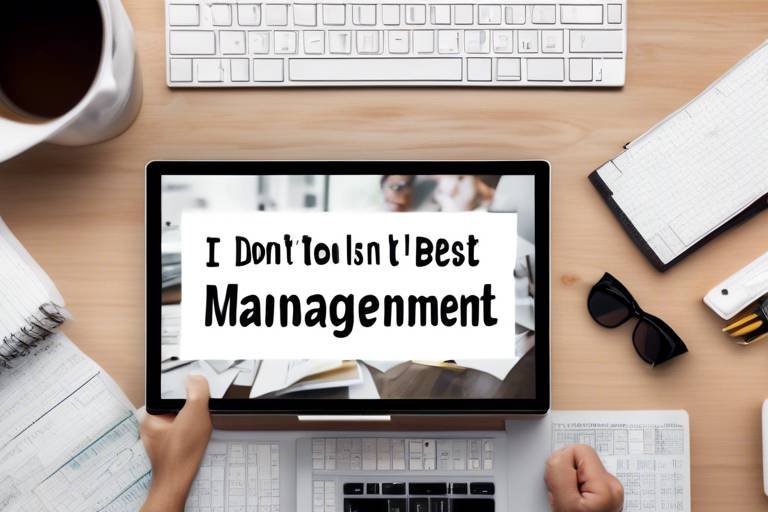How to Use the 80/20 Rule to Maximize Your Productivity
Are you looking to supercharge your productivity and achieve more in less time? The 80/20 rule, also known as the Pareto Principle, might just be the key to unlocking your full potential. This principle suggests that 80% of your results come from 20% of your efforts. By understanding and applying this rule effectively, you can prioritize tasks efficiently and focus on what truly matters.
Imagine if you could identify the critical 20% of tasks that yield 80% of your desired outcomes. How much more could you accomplish if you eliminated time-wasting activities and honed in on the most important tasks? The 80/20 rule offers a roadmap to maximizing your productivity and achieving your goals with precision.
By setting clear goals and priorities that align with this principle, you can streamline your workflow and concentrate on tasks that drive the most significant progress. Time management techniques such as prioritization, delegation, and time blocking can further enhance your efficiency and ensure that you make the most of your valuable time.
Tracking your progress and analyzing the outcomes of applying the 80/20 rule is crucial for continuous improvement. By measuring the impact of your efforts and making necessary adjustments, you can optimize your productivity and stay on course towards your objectives.
Consistency is key when it comes to applying the 80/20 rule, but it's also essential to remain adaptable to changing circumstances. Finding the right balance between routine and flexibility will help you sustain long-term productivity gains and navigate challenges effectively.
Embrace the mindset of continuous improvement and commit to regularly reassessing your tasks, priorities, and goals. By optimizing your efficiency and effectiveness over time, you can unlock your full potential and achieve remarkable results.

Understanding the 80/20 Rule
Learn how the 80/20 rule, also known as the Pareto Principle, can help you prioritize tasks efficiently and achieve more in less time. Discover practical tips for applying this principle to boost your productivity and focus.
The 80/20 rule, or the Pareto Principle, is a concept that suggests 80% of results come from 20% of efforts. Imagine if you could focus on the vital 20% that brings about 80% of your desired outcomes. This principle can be a game-changer in various aspects of life, from work to personal goals.
Discover strategies to identify the crucial 20% of tasks that yield 80% of your desired results. By honing in on these key tasks, you can significantly enhance your productivity and achieve your goals more effectively.
Find out how to eliminate non-essential tasks that consume time and energy without providing significant returns. Streamline your workflow by prioritizing high-impact activities and reducing distractions to make the most of your time.
Setting clear goals and priorities is crucial to align your efforts with the 80/20 rule. Effective goal setting enables you to concentrate on tasks that drive significant progress towards your objectives, ensuring that you stay on track and focused.
Explore time management techniques that complement the 80/20 rule, such as prioritization, delegation, and time blocking. These strategies can enhance your efficiency and help you focus on essential tasks that contribute most to your overall success.
Understanding the impact of applying the 80/20 rule requires measuring and analyzing your progress. By tracking your efforts and outcomes, you can make informed decisions to adjust your approach and maximize your productivity effectively.
Consistency is key when applying the 80/20 rule, but it's also essential to remain adaptable to changing circumstances. Striking a balance between routine and flexibility is crucial for sustaining long-term productivity gains and ensuring continued success.
Adopting a mindset of continuous improvement can further enhance your productivity over time. Regularly reassessing your tasks, priorities, and goals allows you to optimize your efficiency and effectiveness, leading to ongoing growth and success.

Identifying Your Most Important Tasks
Learn how the 80/20 rule, also known as the Pareto Principle, can help you prioritize tasks efficiently and achieve more in less time. Discover practical tips for applying this principle to boost your productivity and focus.
When it comes to maximizing productivity, identifying your most important tasks is crucial. The 80/20 rule suggests that 80% of your desired results come from 20% of your efforts. This means that a few key tasks contribute significantly more to your goals than others. By pinpointing these crucial tasks, you can focus your energy and time where it matters most.
One effective way to identify your most important tasks is to evaluate the impact each task has on your overall objectives. Consider which activities directly contribute to your desired outcomes and which ones are merely time-fillers. By prioritizing tasks that align with your goals and yield the most significant results, you can ensure that your efforts are well-directed.
Additionally, analyzing past performance can help you identify patterns of success. Look back at previous projects or tasks and determine which activities led to the most positive outcomes. By recognizing these trends, you can prioritize similar tasks in the future to replicate success and maximize productivity.
Furthermore, consider the consequences of not completing certain tasks. Some activities may have higher stakes or long-term implications, making them more critical to your overall success. By assessing the potential impact of each task, you can prioritize those that are essential for achieving your goals.
Incorporating tools such as task management software or productivity apps can also assist in identifying and organizing your most important tasks. These tools can help you track progress, set deadlines, and allocate resources efficiently, ensuring that you stay focused on the activities that drive the most significant results.

Eliminating Time-Wasting Activities
When it comes to maximizing productivity, one of the key strategies is eliminating time-wasting activities. These are tasks that do not contribute significantly to your goals and consume valuable time and energy. By identifying and eliminating these non-essential activities, you can streamline your workflow and focus on what truly matters.
One effective way to eliminate time-wasting activities is to prioritize your tasks based on their impact. Identify the high-impact activities that align with your goals and focus on completing them first. By concentrating on tasks that yield the most significant results, you can avoid getting bogged down by less important activities.
Another approach to eliminating time-wasting activities is to delegate tasks that can be handled by others. Delegating responsibilities not only frees up your time but also allows you to leverage the skills and expertise of your team members. By assigning tasks to the right people, you can ensure that every activity contributes to the overall productivity of the team.
Furthermore, it is essential to reduce distractions that can derail your focus and productivity. Identify common distractions in your work environment, such as excessive meetings, email notifications, or social media browsing, and take steps to minimize their impact. By creating a conducive work environment free from distractions, you can optimize your concentration and efficiency.
Moreover, implementing time blocking techniques can help you eliminate time-wasting activities by structuring your day around specific tasks. By allocating dedicated time blocks for different activities, you can prevent multitasking and ensure that each task receives your full attention. This focused approach can significantly reduce time wastage and enhance your overall productivity.

Setting Clear Goals and Priorities
Setting clear goals and priorities is essential to effectively apply the 80/20 rule and maximize your productivity. Think of your goals as the destination on a map and your priorities as the route you take to get there. Without a clear destination and a planned route, you may find yourself wandering aimlessly, wasting time and energy on tasks that do not contribute significantly to your overall objectives.
When setting goals, make sure they are specific, measurable, achievable, relevant, and time-bound (SMART). By defining clear objectives, you create a roadmap that guides your efforts towards the most impactful tasks. Prioritizing these goals based on their importance and alignment with the 80/20 rule allows you to focus on activities that generate the most significant results.
Consider creating a table or a visual representation of your goals and priorities to gain a clear overview of what needs to be accomplished. This visual aid can serve as a constant reminder of where to direct your energy and attention, helping you stay on track and avoid getting sidetracked by less critical tasks.
Furthermore, regularly reassess your goals and priorities to ensure they remain relevant and aligned with your overarching objectives. As you progress, you may need to adjust your focus based on changing circumstances or new insights. By staying flexible and adaptive in your goal-setting process, you can optimize your productivity and maintain momentum towards your desired outcomes.

Optimizing Time Management Techniques
Optimizing Time Management Techniques involves a strategic approach to managing your time effectively to maximize productivity. One key technique aligned with the 80/20 rule is prioritization. By identifying and focusing on the most critical tasks that contribute significantly to your goals, you can ensure that your time and energy are invested where they will yield the highest returns. This approach allows you to work smarter, not harder, by concentrating on activities that drive the most significant results.
Another essential technique is delegation, which involves assigning tasks to others to free up your time for more high-impact activities. Delegating tasks that fall outside of your core strengths or require less expertise can help you optimize your time and ensure that you are focusing on tasks that align with the 80/20 principle. By entrusting certain responsibilities to others, you can increase efficiency and productivity while maintaining a strategic focus on your most important objectives.
Time blocking is another effective time management technique that can enhance your productivity. By allocating specific time blocks for different tasks or categories of activities, you can create a structured schedule that allows you to concentrate fully on one task at a time. This approach helps minimize distractions and multitasking, enabling you to work with greater focus and efficiency. Time blocking also ensures that you allocate sufficient time to your most critical tasks, aligning with the principles of the 80/20 rule.

Measuring and Analyzing Your Results
When it comes to maximizing productivity using the 80/20 rule, measuring and analyzing your results play a crucial role in determining the effectiveness of your efforts. By tracking your progress and evaluating the outcomes of applying the Pareto Principle, you can gain valuable insights into which tasks are yielding the most significant results.
One effective way to measure your results is to keep a detailed record of the tasks you have completed and the outcomes they have produced. This can help you identify patterns and trends in your productivity levels, allowing you to make informed decisions about where to focus your efforts.
Additionally, analyzing your results involves assessing the impact of the tasks you have prioritized based on the 80/20 rule. By comparing the outcomes of these key tasks to those that are less significant, you can determine whether you are allocating your time and resources effectively.
It is essential to set specific metrics and benchmarks to measure the success of your productivity efforts accurately. Whether it is tracking the completion time of tasks, the quality of outcomes, or the overall progress towards your goals, having quantifiable data can help you evaluate your performance objectively.
Moreover, analyzing your results allows you to identify areas for improvement and optimization. By understanding which tasks contribute the most to your desired outcomes, you can make strategic adjustments to your workflow to enhance efficiency and effectiveness.
Remember, the key to leveraging the 80/20 rule for maximum productivity is not only in prioritizing tasks but also in continuously measuring and analyzing your results. By staying proactive in monitoring your progress and making data-driven decisions, you can refine your approach and achieve greater success in your endeavors.

Maintaining Consistency and Adaptability
Maintaining consistency and adaptability are key factors in successfully applying the 80/20 rule to maximize productivity. Consistency ensures that you stay focused on the most important tasks that contribute significantly to your goals. By consistently prioritizing the crucial 20% of activities, you can consistently achieve the desired 80% of results. It's like tending to a garden; you need to consistently water the most important plants to ensure a bountiful harvest.
However, adaptability is equally crucial in the face of changing circumstances and unexpected challenges. While consistency provides stability, adaptability allows you to pivot when necessary and adjust your focus to address new priorities or opportunities. It's about being like a skilled surfer, riding the waves of change while staying true to your course towards productivity.
Striking a balance between consistency and adaptability requires a nuanced approach. You need to establish routines and habits that support your productivity goals while remaining open to feedback and willing to make adjustments as needed. It's about building a strong foundation of consistency while being flexible enough to navigate the twists and turns of life.

Embracing Continuous Improvement
Embracing continuous improvement is like tending to a garden; just as a gardener nurtures plants to grow and flourish, you must nurture your skills and productivity to reach your full potential. This mindset involves constantly seeking ways to enhance your efficiency and effectiveness, always striving for better results. By embracing continuous improvement, you acknowledge that there is always room for growth and development, pushing yourself to go beyond your current capabilities.
One way to embrace continuous improvement is by regularly assessing your performance and identifying areas for enhancement. This self-reflection allows you to pinpoint strengths and weaknesses, enabling you to focus on areas that need improvement. By setting small, achievable goals and consistently working towards them, you create a culture of continuous learning and progress.
Moreover, seeking feedback from others can provide valuable insights into your performance and areas for improvement. Constructive criticism and suggestions from mentors, colleagues, or even clients can help you gain a fresh perspective and identify blind spots that you may have overlooked. Embracing feedback with an open mind is essential for personal and professional growth.
Additionally, staying updated with industry trends, best practices, and new technologies is crucial for continuous improvement. By investing time in learning and acquiring new skills, you can adapt to changing environments and stay ahead of the curve. Continuous learning not only enhances your expertise but also boosts your confidence and adaptability in the face of challenges.
Furthermore, celebrating small victories along the way is essential in embracing continuous improvement. Recognizing your progress and achievements, no matter how minor, motivates you to keep pushing forward and striving for excellence. By acknowledging your efforts and successes, you reinforce a positive mindset that fuels your drive for continuous growth.
Frequently Asked Questions
- What is the 80/20 rule, and how does it relate to productivity?
The 80/20 rule, also known as the Pareto Principle, suggests that 80% of results come from 20% of efforts. In terms of productivity, this means that focusing on the most important tasks that yield the greatest results can significantly boost efficiency and output.
- How can I identify the most important tasks to apply the 80/20 rule?
To identify the crucial 20% of tasks that contribute to 80% of your desired outcomes, analyze your current tasks based on their impact and results. Look for patterns and prioritize tasks that align with your goals and objectives.
- What are some practical tips for implementing the 80/20 rule in daily life?
Some practical tips include creating a prioritized task list, delegating non-essential tasks, setting clear goals, minimizing distractions, and regularly evaluating your progress to ensure you are focusing on high-impact activities.
- How can I measure the effectiveness of applying the 80/20 rule?
Measuring effectiveness involves tracking your tasks and outcomes, analyzing the results, and adjusting your approach accordingly. Keep a record of your progress, assess the impact of focusing on key tasks, and make necessary changes to optimize productivity.
- Is the 80/20 rule applicable to all aspects of life, not just productivity?
Yes, the 80/20 rule can be applied to various areas such as time management, goal setting, decision making, and resource allocation. By identifying and prioritizing the most critical factors, you can enhance efficiency and achieve better results in different aspects of life.


















